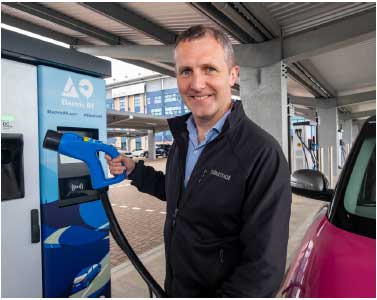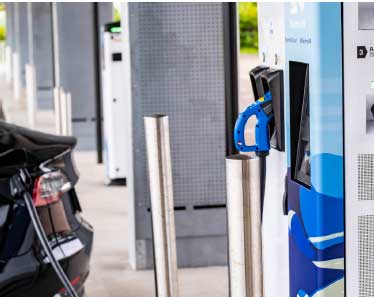European Structural and Investment Funds Programmes in Scotland: 2020 case studies booklet
A publicity booklet to celebrate and promote the achievements of the 2014-2020 European Structural and Investment Funds Programmes in Scotland.
6. Sustainable Growth
Sustainable Growth means investing European Regional Development Fund (ERDF) support to make Scotland a greener, cleaner place to live and work.
Working since 2014 with Lead Partners, the Scottish Government has allocated approximately £164m in ERDF grant towards our Sustainable Growth areas. These include:
- Green Infrastructure
Improving the quality, accessibility and quantity of green areas in Scotland’s towns and cities to address inequality and improve public health. - Scotland’s 8th City – The Smart City
Addressing urban challenges by using new technologies and data, improving sustainability, resilience and service efficiency across all Scottish cities. - Natural and Cultural Heritage Fund
Investing in infrastructure supporting the sustainable use of natural and cultural heritage assets in the Highlands and Islands region. - Low Carbon Infrastructure Transition Programme
Supporting the shift towards a low-carbon economy, encouraging investment in technology and development to exploit Scotland’s low-carbon potential. - Low Carbon Travel and Transport Programme
Increasing the number of journeys made by public transport, low-energy vehicles, on foot and by bike. - Resource Efficient Circular Economy
Promoting environmental innovation and performance management in the public and private sectors, and increasing business competitiveness by increasing resource efficiency. - Digital Infrastructure
Delivering 100% superfast broadband access and improving the availability of mobile connectivity across the Highlands and Island region.
Lead Partners:
- Local authorities;
- NatureScot;
- Transport Scotland;
- Zero Waste Scotland;
- Scottish Government Digital Directorate;
- Scottish Government Directorate for Energy and Climate Change; and
- Scottish Cities Alliance.
6.1 Powering electric vehicles and low carbon travel options
The Low Carbon Travel and Transport Programme is managed by Transport Scotland and aims to boost the number of journeys made by public transport, low-energy vehicles, bike and on foot.
Working with the Energy Saving Trust, local authorities across Scotland have been able to increase low- carbon and active travel options for people, businesses and communities thanks to European Regional Development Fund (ERDF) support.
Falkirk Council used the funding to create one of the largest electric vehicle (EV) charging stations in Scotland. The £1.4m facility at the Falkirk Stadium, which has capacity for 26 electric vehicles, was officially opened by Michael Matheson MSP, Cabinet Secretary for Transport, Infrastructure and Connectivity on 11 August 2020.
The EV station generates over 30% of the required electricity to power the facility from its own solar canopy made up of 1,272 panels, saving 75 tonnes of carbon per year.
£22.3m of ERDF support has been allocated to the Low Carbon Travel and Transport Programme
“This hub entirely supports the Scottish Government’s bold ambition to phase out the need for new petrol and diesel cars and vans by 2032. These 26 charging bays, including fast and rapid chargers, are welcome additions to our public electric vehicle charging network – ChargePlace Scotland. I know that this facility is already greatly appreciated by people visiting and living in Falkirk who have made the switch to electric vehicles and are already experiencing the many benefits that they bring.” Michael Matheson MSP, Cabinet Secretary for Transport, Infrastructure and Connectivity

Key Falkirk Stadium EV station facts:
- The self-service facility is open 24/7 all year round;
- 10 rapid (50kW) charging bays;
- 16 fast (22kW) charging bays;
- 3 designated bays for disabled users;
- 1,272 TrinaSolar panels generating an estimated 300,644kWh annually;
- Bluetop solar canopy covers 2,082sqm – equivalent to almost a third of a football pitch; and
- Energy generated will be stored in 3 storage systems capable of holding up to 201kWh of energy and delivering up to 183kW of power.

6.2 Transforming vacant land into new greenspace in urban areas
The Green Infrastructure Fund is managed by NatureScot. Working with local authorities, housing associations, and other public sector organisations, it targets urban areas in Scotland that have a deficit of good quality greenspace, an excess of vacant land and suffer from multiple levels of deprivation.
One such area is in north Glasgow, between Firhill and Sighthill. The Canal and North Gateway project, supported by the European Regional Development Fund (ERDF), is creating new greenspace for local communities and a new habitat that will enable wildlife to flourish.
The Canal and North Gateway Project is made up of two parts:
1. Improving access to and within Claypits Local Nature Reserve.
The plans for the reserve feature a barrier-free path and boardwalk network, mountain bike trail, disabled access fishing pegs, re-designed gateway entrances, viewpoints, and a feature canal pedestrian bridge. This is dramatically improving active travel options for the local community, especially the new bridge which links Maryhill and Woodside communities with Hamiltonhill and Possilpark.
2. Providing a surface water drainage solution for the regeneration of key vacant and derelict sites, including Sighthill.
This is achieved by dynamically managing the water level in the canal to provide flood storage, mitigating the predicted increase in rainfall associated with climate change and allowing for flora and fauna to thrive in a new habitat network.
The Canal and North Gateway project is not only playing its part in the wider regeneration of north Glasgow and the Scottish canal network, but will relieve pressure on current greenspaces that experienced increased use during the COVID-19 lockdown.
Thanks to ERDF support, the people of north Glasgow have vital blue-green infrastructure and a new active travel network on their doorstep.
Green Infrastructure projects have been supported with an ERDF allocation of £17.7m
6.3 Connecting communities across the Highlands and Islands
The Scottish Government‘s £25 million 4G Infill Programme is improving Scotland’s rural mobile phone coverage in selected ‘not spots’ – areas where no commercial coverage has been rolled out. Without this intervention, these rural areas would miss out on improved connectivity and the benefits this could bring to home, working life and the wider local economy.
Strathconon is one such site in the Highlands and Islands region. Its new mobile phone mast was installed in October 2020 thanks to support from the European Regional Development Fund (ERDF).
Not only does this mast provide improved 4G coverage, but it will also play a vital role in the Emergency Services Network. Thanks to ERDF support, police, ambulance and mountain rescue emergency services can provide rapid response to local and national crises, offering better resilience as a result of improved communication between people in the control rooms and those out in the field.
For the local community, improved 4G coverage potentially makes the area more attractive to tourists and offers social benefits, such as improved access to services and keeping in touch during COVID-19.
Digital connectivity projects in the Highlands and Islands have been allocated £20m of ERDF support
“Improved mobile connectivity has made such a difference to myself, my wife and the local community. Thanks to the ERDF-supported programme, we can now connect to faster, reliable speeds, which is crucial during the current pandemic. Like many people living in Strathconon and the surrounding area, I work from home and now I’m able to take part in online meetings without experiencing time lags and colleagues talking over each other due to the poor connection.” John Turner, Local resident
6.4 Installing ‘intelligent’ street lighting in Aberdeen
The ‘Scotland’s 8th City – the Smart City’ is an ambitious programme of collaborative innovation across Scotland’s seven cities of Aberdeen, Dundee, Edinburgh, Glasgow, Inverness, Perth, and Stirling. By working and sharing knowledge together, the cities have been able to become more attractive, liveable and resilient through use of data and digital technology.
For example, thanks to European Regional Development Fund (ERDF) support, Aberdeen City Council has been able to replace old inefficient street lighting with brand new LED optical units along a high profile area in the centre of Aberdeen. This change has reduced energy consumption by up to 60% compared with the old units, bringing down the city’s carbon footprint and energy bills.
There is now adaptive control of the lighting system remotely through a central management system. This means the system can alert users to any faults as they occur, removing the need to wait for a complaint to come through from the public.
However, the new street lighting does more than just illuminate the area. Sensors have been installed on the street lights that provide data on when interventions are required to prevent flooding, enabling the council to be ahead of the curve and reduce the level of disruption. Nearby road safety signs have also been connected to the same system so that they can be switched on and off as required.
This ERDF project has not only contributed to the council’s ambition to implement a variety of ‘Smart City’ solutions, but also created a more efficient and safer environment for the people of Aberdeen.
£22.2m of ERDF support has been allocated to ‘Scotland’s 8th City – the Smart City’
Contact
There is a problem
Thanks for your feedback